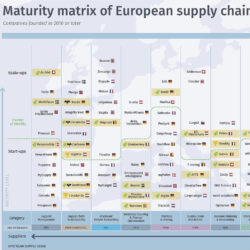Emission reporting: how to map Scope 3

Sustainability was hot during inNOWvate. Which is not surprising now that the Corporate Sustainability Reporting Directive (CSRD) is entering into force and companies are getting nervous about the reporting obligations it entails. Fortunately, software vendors BigMile, Gryn and Carbmee showed that you can automate many of these emissions reporting so that it requires hardly any work.
By Mirjam Hulsebos
The European CSRD regulation already covers listed companies and they must report on the carbon emissions of their entire chain, both upstream and downstream. Somewhat later, this law will also apply to medium-sized companies. Across Europe, as many as 50,000 companies will be subject to reporting requirements. This also has an impact on all B2B customers and suppliers of these companies, as they are the ones who will have to provide information on Scope 3 emissions.
In larger companies there are easily hundreds or thousands of suppliers, so collecting all the data manually and putting it into an auditable format is a huge undertaking, especially since it is not a one-off activity but an ongoing one. This is why many software suppliers have jumped into that gap.
Transport emissions
BigMile and Gryn both provide a solution to understand the carbon emissions associated with transport. Based on cargo type, origin, destination and type of transport, the software uses industry standards to calculate the CO2 emissions associated with that transport. Both tools have various dashboards to provide insight into their share of emissions per customer, supplier or transporter.
Tools like those from BigMile and Gryn use data already captured somewhere as much as possible, in your TMS or ERP system, for example. Through open APIs, you can also unlock applications from your 3PL. ‘The key is that you have to do as little manual work as possible to create the reports,’ said Auke Annema (pictured above) of BigMile.
 If you only want to use data from other systems like this, there obviously has to be a data quality check, and the data has to be made uniform and mapped. To do this, both tools use artificial intelligence (AI). Oliver Ritzman of Gryn: ‘AI recognizes immediately if one application uses The Netherlands and another uses Netherlands or Holland for example, and straightens that out. There’s actually no human hand involved in that anymore.’
If you only want to use data from other systems like this, there obviously has to be a data quality check, and the data has to be made uniform and mapped. To do this, both tools use artificial intelligence (AI). Oliver Ritzman of Gryn: ‘AI recognizes immediately if one application uses The Netherlands and another uses Netherlands or Holland for example, and straightens that out. There’s actually no human hand involved in that anymore.’
Production emissions
Besides transport, for the manufacturing industry, another major emission category that falls under Scope 3 is obviously the emissions associated with the production of the raw materials or semi-finished products you purchase. Preferably, you would also like to map these emissions fully automatically, which is possible with Carbmee’s software, among others. Based on the bill of materials, this solution automatically maps out what carbon emissions you can assume. They also use industry standards. ‘Because most suppliers themselves have no idea of their actual emissions,’ commented Alina Biermann of Carbmee.
 Carbmee does not just focus on CSRD reporting but also helps clients reduce their emissions. Biermann: ‘More and more sectors are coming under the ETS (Emission Trading System), so it is becoming increasingly financially attractive to reduce your carbon emissions. We help our clients find alternatives and calculate the business case. For example, if you replace this raw material with that one, your procurement costs may be higher, but you save so much in carbon emissions.’
Carbmee does not just focus on CSRD reporting but also helps clients reduce their emissions. Biermann: ‘More and more sectors are coming under the ETS (Emission Trading System), so it is becoming increasingly financially attractive to reduce your carbon emissions. We help our clients find alternatives and calculate the business case. For example, if you replace this raw material with that one, your procurement costs may be higher, but you save so much in carbon emissions.’










